
1
Lect. No. 4 & 5 Dr.Farah Hazem
Bacterial genetics
Genetics
is the study of genes, heredity, and genetic variation in living organisms
It is generally considered a field of biology
The Bacterial Genome
The genome of an organism is defined as the totality of its genetic material. For
bacteria, the genome consists of a single chromosome that carries all of the
essential genes and one or more varieties of plasmid that generally carry
nonessential genes.
Gene
: A gene is a locus (or region) of DNA that encodes a functional RNA or
protein product, and is the segments of DNA located on chromosomes. Genes
contain the codes for the production of specific proteins.
Phenotype
: it is the collective structural and physiological properties of a cell or
an organism (eg. Resistance against one or several antibiotics or poisons in the
bacteria.
Genotype: the alteration in the sequence of DNA within a gene or in
The organization of genes.
Change in genotype hs the chemical basis for variation in
phenotype.

2
A. The chromosome
All of the essential genes and many nonessential genes of the bacterium are carried
on a single, long piece of circular, double-stranded DNA. This molecular structure
is called “the chromosome”. The chromosome, along with several proteins and
RNA molecules, forms an irregularly shaped structure called the nucleoid. This sits
in the cytoplasm of the bacterial cell. . Most bacteria have chromosomes that
contain 2000 to 4000 genes.
B. Extra chromosomal elements
In addition to the chromosomes, many bacteria posses smaller, independently
replicating(extra chromosomal) termed:
1.plasmids
2.episomes
3.transposons
4.bacteriophage
1. Plasmids
Typically, bacteria contain small DNA circles (plasmids), its size is usually less
than one-tenth the size of the bacterial chromosome. Their size varies from 1 kbp
to over 400 kilobase pairs (kbp).
Bacteria can pick up new plasmids from other
bacterial cells (during conjugation) or from the environment. They can also readily
lose them – for instance, when a bacterium divides in two, one of the daughter cells
might miss out on getting a plasmid.

3
Every plasmid has its own ‘origin of replication’ – a stretch of DNA that ensures it
gets replicated (copied) by the host bacterium. For this reason, plasmids can copy
themselves independently of the bacterial chromosome, so there can be many
copies of a plasmid – even hundreds – within one bacterial cell. Plasmids can carry
genes for toxins and for proteins that promote the transfer of the plasmid to other
cells, but usually do not include genes that are essential for cell growth or
replication.
Plasmids are cloning vectors that are widely used in molecular biology
and they play important roles in the genetic engineering
.
plasmid can be
either:
a.Transmissible
:
transfer to another cell by gonjugation example:
1.
Fertility-(F) plasmids,
They are capable of conjugation (they contains the genes for the pili)
.
2. Resistance-(R) plasmids
,
contain gene (s) that can build resistance against one or several antibiotics or
poisons.
b. non Transmissible
:not transfer to another cell
1. Col-plasmids,
contain genes coding for colicines, proteins that can kill other bacteria.
2. Degradative plasmids,
able to digest unusual substances, e.g., toluene or salicylic acid.
3. Virulence plasmids,
turn a bacterium into a pathogen.
2. Transposones:
these are mobile DNA séquense that can move between
plasmids and between plasmid and bacteria. THEY ARE OF TWO KINDS:
a. simple transposones ;carry only genetic informations such as drug resistance.

4
3.
Episones:
genetic elements that canbe integrated in the host cell chromosomes
4.
Bacteriophage:
A bacteriophage (phage) are obligate intracellular parasites that multiply inside
bacteria by making use of some or all of the host biosynthetic machinery. (phage)
is a virus that replicates inside a bacterial cell; it consists of a piece of nucleic acid
encapsulated in a protective protein coat. Depending on the phage, the nucleic acid
can be DNA or RNA, double-stranded or single-stranded, and range in size from
about 3 genes to about 200 genes. The typical replicative cycle begins with
attachment of the phage to receptors on the cell surface, followed by injection of
the nucleic acid into the bacterial cell, leaving all or most of the protein outside the
cell. [Note: This is in contrast to viral infection of vertebrate cells, in which the
entire virus is taken up by the cell, and its nucleic acid released intracellularly. The
phage nucleic acid takes over the cell's biosynthetic machinery to replicate its own
genetic material, and to synthesize phage-specific proteins. When sufficient coat
proteins and new phage DNA have accumulated, these components self-assemble
into mature phage particles, with the DNA encapsulated by the phage coat. Release
of new phage particles is accomplished by a phage-specific enzyme (lysozyme)
that dissolves the bacterial cell wall.
Types of phage:
A. Virulent phage:
Results in the death of the cell by lysis, with release of newly replicated phage
particles. Under optimal conditions, a bacterial cell infected with only one phage
particle can produce hundreds of progeny in twenty minutes.

5
B. Temperate phage
A bacterium infected with a temperate phage can have the same fate as a bacterium
infected with a virulent phage (lysis rapidly following infection). However, an
alternative outcome is also possible, namely, after entering the cell, the phage
DNA, rather than replicating autonomously, can fuse or integrate with the
chromosome of the host cell. In this state (prophage), the expression of phage
genes is repressed indefinitely by a protein (repressor) encoded within the phage
genome. No new phage particles are produced, the host cell survives, and the
phage DNA replicates as part of the host chromosome.
Gene Transfer
Genetic recombination
- transfer of DNA from one organism (donor) to
another recipient
Genes can be transferred from one bacterial cell to another by three distinct
mechanisms: conjugation, transduction, and transformation. Because the
transferred DNA usually does not contain an origin of replication, these genes will
be passed on to succeeding generations only if the transferred DNA becomes
incorporated into the recipient chromosome, which has an origin of replication.
A. Conjugation
Conjugation is the process by which bacteria transfer genes from one cell to
another by cell-to-cell contact. The donor (male) and recipient (female) cells must
have the proper genetic constitution to adhere to each other, and form a
cytoplasmic bridge between the cells through which DNA can pass. Specifically,
the process requires the presence on the donor cell of hair-like projections called
sex pili that make contact with specific receptor sites on the surface of the recipient

6
cell. This contact results in the formation of a relatively stable cell pair, and the
initiation of DNA transfer.
B. Transduction
Transduction refers to transfer of genes from one cell to another via a phage vector
without cell-to-cell contact. Phage that undergo this process are temperate phages
Which can transfer one portion of DNA from one bacterium to another.
There are two ways in which this can occur: generalized transduction and
specialized transduction.
generalized transduction
:a random fragments of bacterial DNA that is
accidentally encapsulated in a phage( lytic phage) instead of its DNA , then this
segments is transferred to another bacterium when this phage infects another
bacteria. due to an error in maturation during the lytic life cycle. a bacteriophage
head or capsid assembles around a fragment of donor bacterium's nucleoid or
around a plasmid instead of a phage genome by mistake. (transduction can transfer
any bacterial genes).
specialized transduction
: only certain bacterial genes located in the bacterial
chromosome in a close proximity to the phage (temperate phage) are transduced .(
transduction only certain group of genes). due to an error in spontaneous induction
during the lysogenic life cycle during spontaneous induction, a small piece of the
donor bacterium's DNA is picked up as part of the phage's genome in place of
some of the phage DNA which remains in the bacterium's nucleoid.
phage particle contains both phage and bacterial DNA joined together as a single
molecule. After infecting another cell, this joint molecule integrates into the

7
recipient chromosome just as phage DNA normally does in the process of
becoming a prophage.
C. Transformation
Transformation is the transfer of genes from one cell to another by means of naked
DNA. The discovery of transformation in 1928, one of the most important in all of
biology, led eventually to the identification of DNA as the genetic material.
The mechanism of DNA uptake includes the presence of specific receptor For
DNA on the surface of the recipient cell and their cell wall must contain
Large pores for the DNA to pass through.
Transformation process: As free, double-stranded DNA enters the recipient cell,
one of the two strands is destroyed by cell nucleases. The remaining single strand
invades the resident chromosome, seeking a region of sequence homology. If such
a sequence is found, the invading strand replaces one of the two resident strands by
a complex cut-and-paste process. Transformation probably has only a minor effect
on gene flow in natural bacterial populations, but it is useful experimentally for
introducing a cloned gene (for example, the human gene for insulin) into bacterial
cells.
Gene Expression:
Genetic information is encoded in DNA, transcribed into mRNA, and translated on
ribosomes through tRNA into the structure of proteins. The mechanism by which
the sequence of nucleotides in a gene determines the sequence of amino acids in a
protein is as follows:

8
(1) RNA polymerase forms a single polyribonucleotide strand, called "messenger
RNA" (mRNA), using DNA as a template; this process is called transcription. The
mRNA has a nucleotide sequence complementary to a template strand in the DNA
double helix.
(2) Amino acids are enzymatically activated and transferred to specific adapter
molecules of RNA, called "transfer RNA" (tRNA). Each adapter molecule has a
triplet of bases (anticodon) complementary to a triplet of bases on mRNA, and at
one end its specific amino acid. The triplet of bases on mRNA is called the codon
for that amino acid.
(3) mRNA and tRNA come together on the surface of the ribosome. As each tRNA
finds its complementary nucleotide triplet on mRNA, the amino acid that it carries
is put into peptide linkage with the amino acid of the preceding (neighboring)
tRNA molecule. The enzyme peptidyl transferase catalyzes the formation of the
peptide bond. The ribosome moves along the mRNA, the polypeptide growing
sequentially until the entire mRNA molecule has been translated into a
corresponding sequence of amino acids. This process, called translation,
Recombinant DNA Biotechnology
(
Gene Cloning)
Recombinant DNA (or rDNA) is teqnique used in genetic engineering that
involves the identification. Isolation and insertion of gene of interest into a vector

9
such as plasmid form a recombinant DNA molecule and production a large
quantities of the gene fragment or product
The process depends on the ability to cut and re-join DNA molecules at points
which are identified by specific sequences of nucleotide bases called restriction
sites. DNA fragments are cut out of their normal position in the chromosome using
restriction enzymes (also called restriction endonucleases) and then inserted into
other chromosomes or DNA molecules using enzymes called ligases.
Steps of recombinant DNA technology
:
1. identification and isolation of gene to be cloned.
2. insertion of this isolated gene into suitable
vector
(any DNA molecule that has
The ability to replicate inside the host cell such as bacteriophage, plasmid
3. introduction of this vector into suitable cell (transformation).
4. Selection of the transformed bacteria or cell by antibiotics resistance or visible
Characteristics.
5. Multiplication or expression of the introduced gene in the host.
Recombinant DNA is used to identify, map and sequence genes, and to determine
their function.
Recombinant human insulin
Almost completely replaced insulin obtained from animal sources (e.g. pigs and
cattle) for the treatment of insulin-dependent diabetes. A variety of different

10
recombinant insulin preparations are in widespread use .Recombinant insulin is
synthesized by inserting the human insulin gene into E. coli, or yeast
(saccharomyces cerevisiae) which then produces insulin for human use.
Polymerase Chain Reaction (PCR)
This is an in vitro method for making many copies of a specific section of DNA,
without the need for vectors or host cells. The DNA to be copied – the template
DNA – is mixed with forward and reverse primers complementary to the end of the
template DNA, nucleotides, and a version of DNA polymerase known as Taq
polymerase. (This enzyme is stable under high temperatures, and is obtained from
the thermophilic bacterium Thermus aquaticus.) The process involves the
repetition of three steps:
denaturation
, which separates the two nucleotide strands of the DNA molecule
primer annealing
, in which the primers bind to the single-stranded DNA
extension
, in which nucleotides are added to the primers – in the 5' to 3' direction –
to form a double-stranded copy of the target DNA.
Each cycle takes a few minutes, and repeated cycles can produce large amounts of
a specific DNA sequence in a matter of hours rather than days. However, this
cloning method does require knowledge of some details about the nucleotide
sequence to be copied, and the technique is very sensitive to small amounts of
contamination.
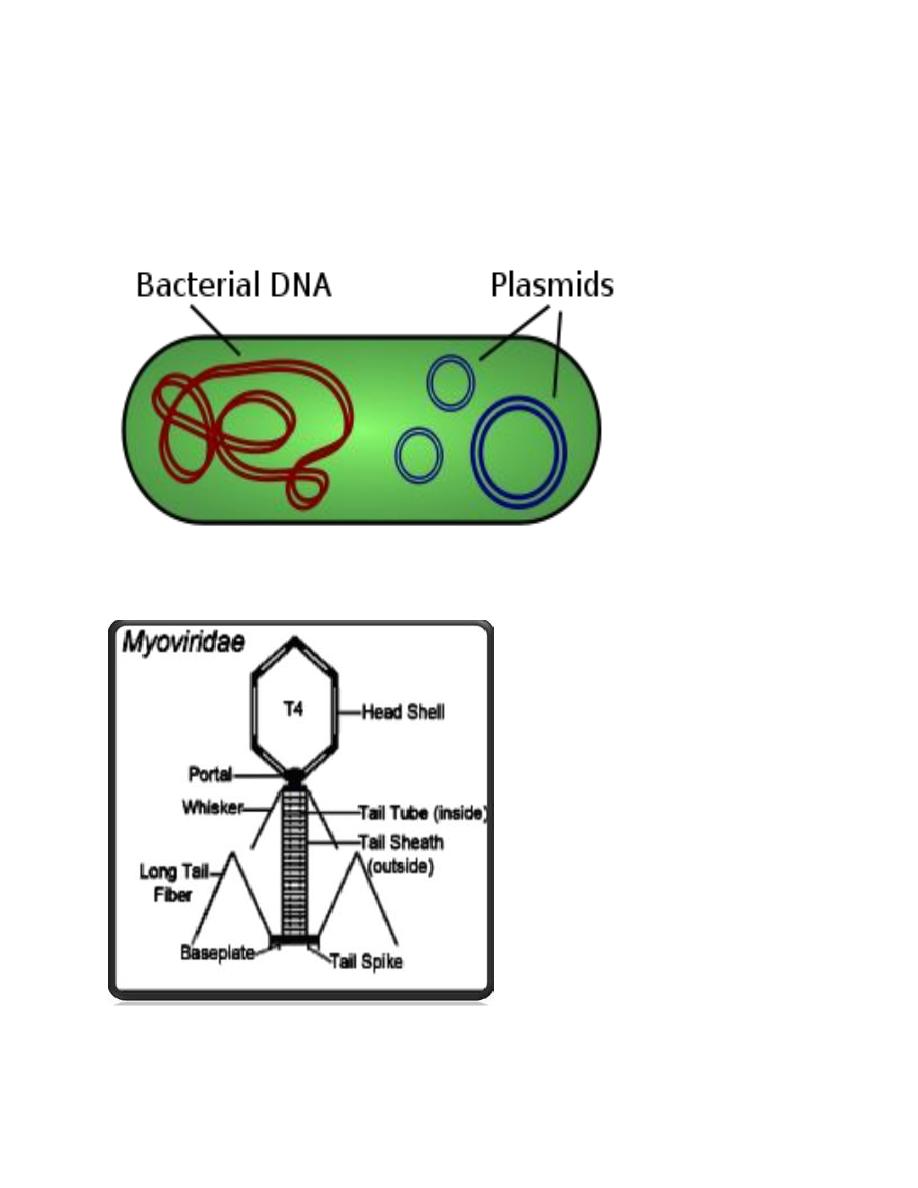
11
Bacteriophage
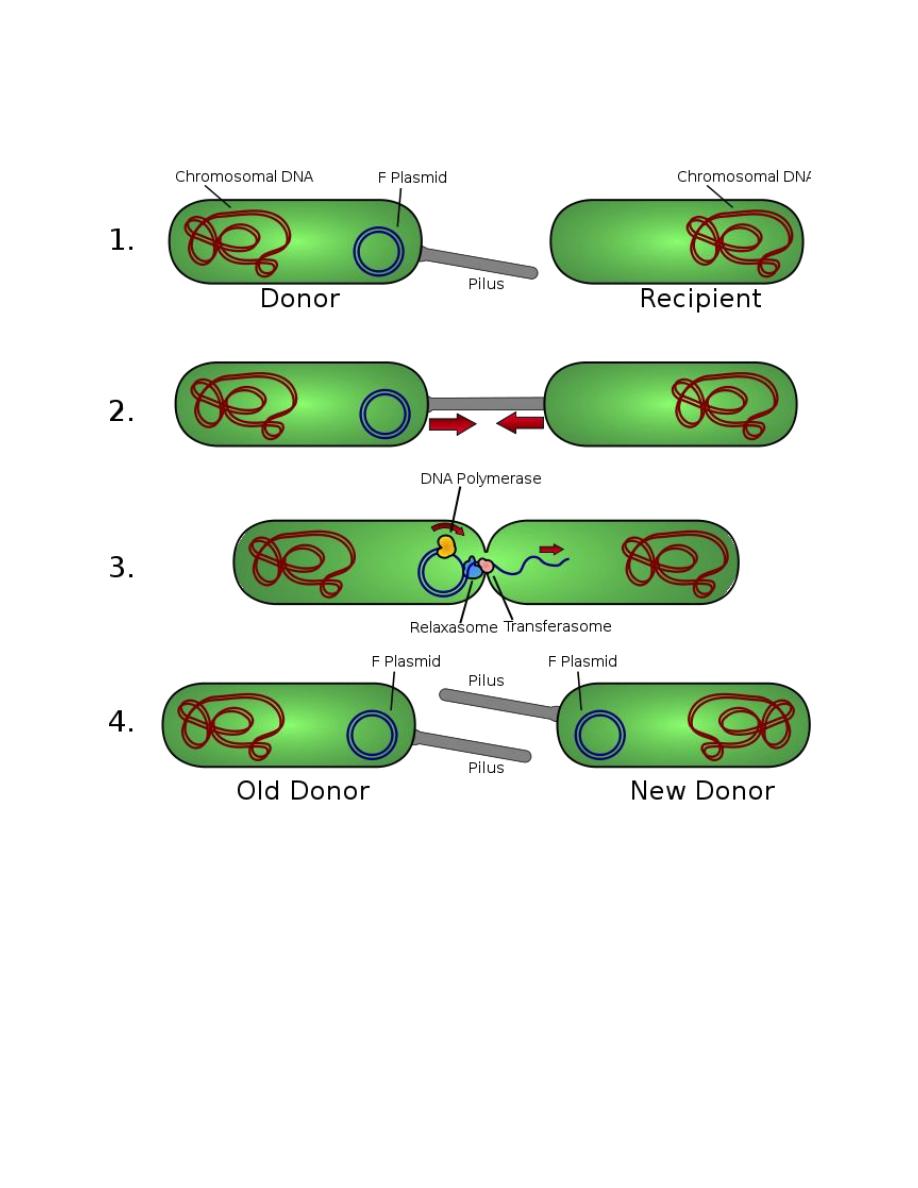
12
Bacterial Conjugation
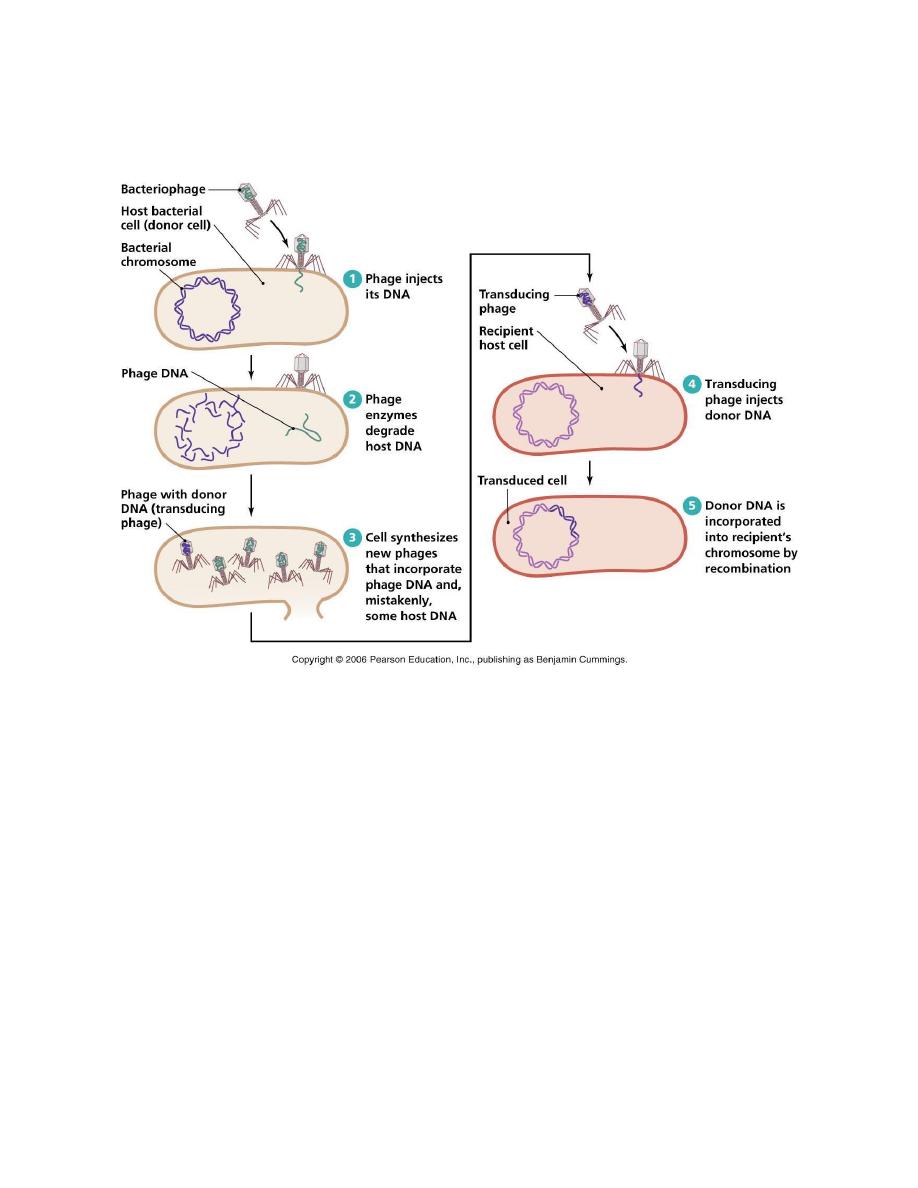
13
Generalized transduction
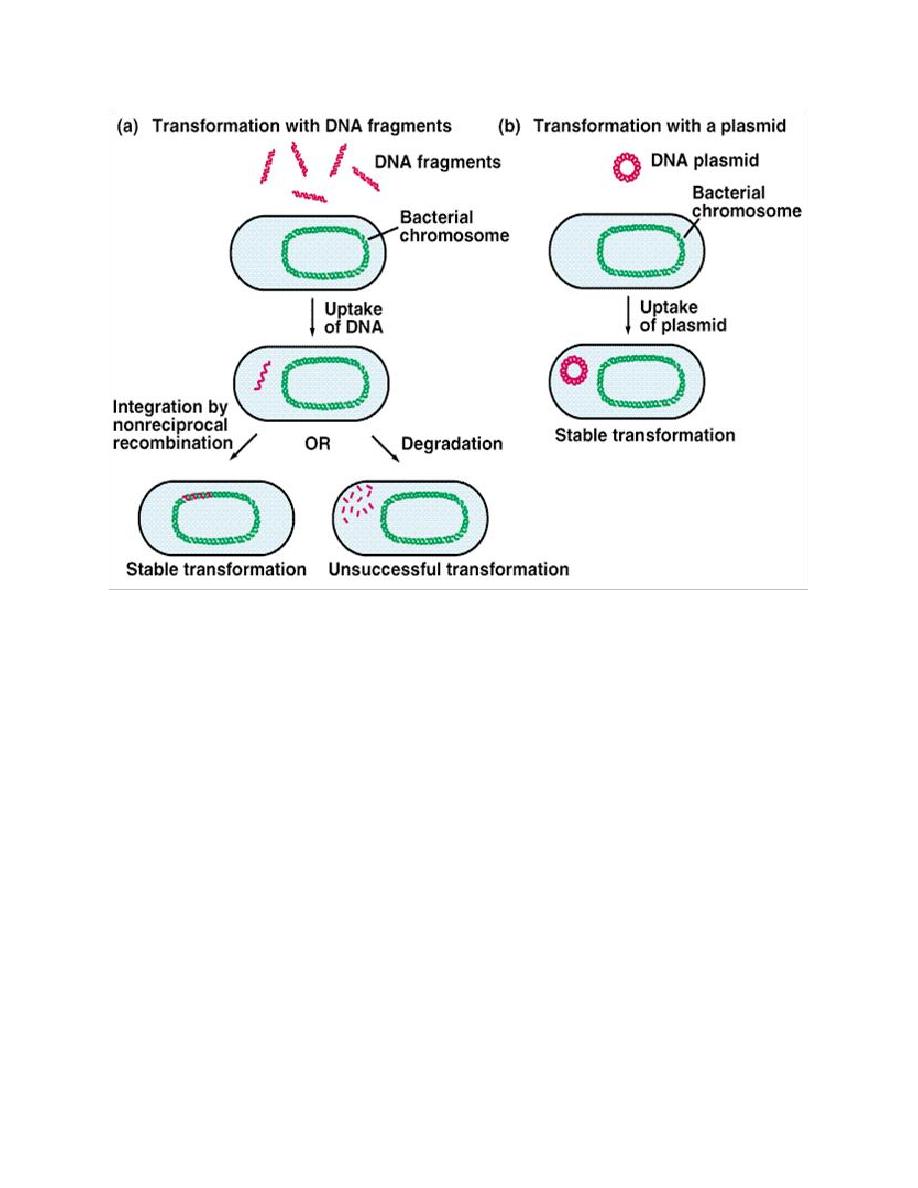
14
Transformation
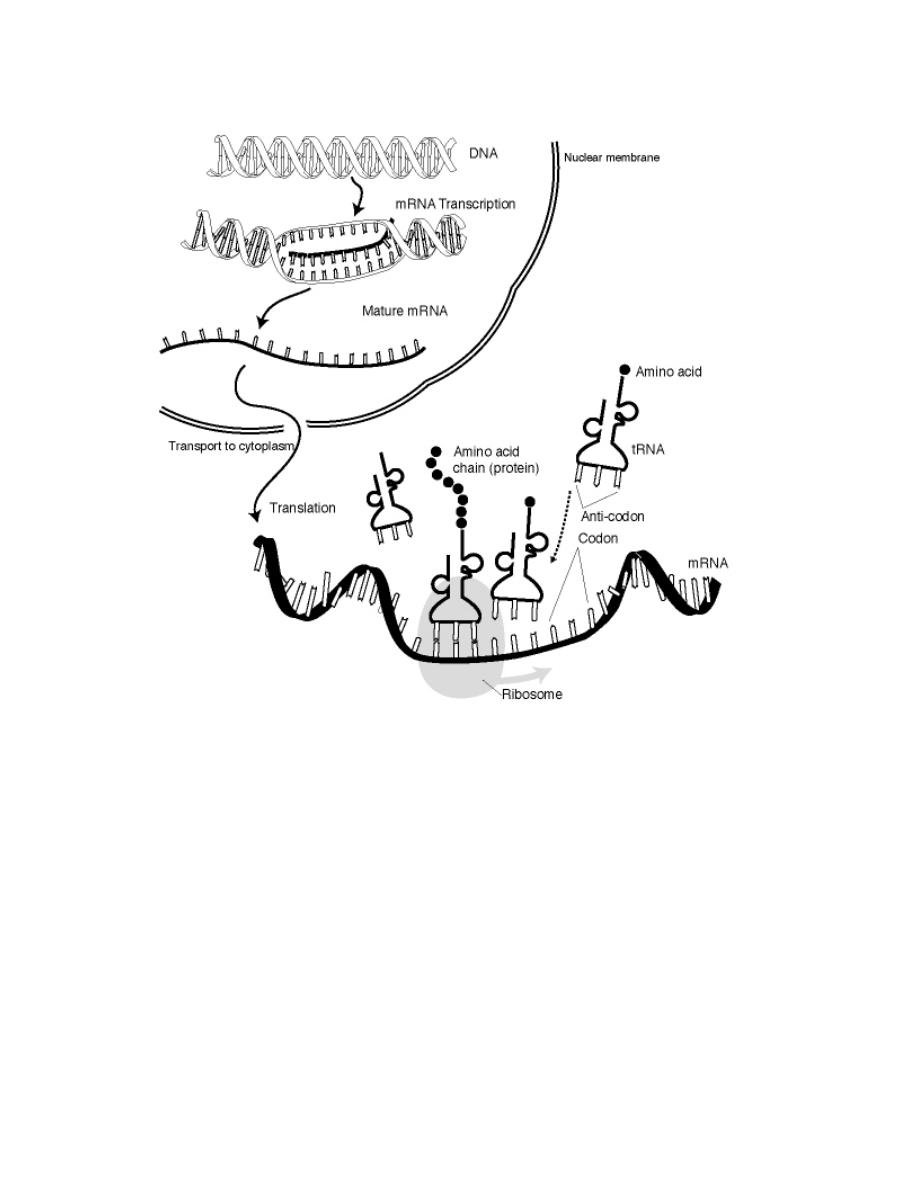
15
Gene Expression
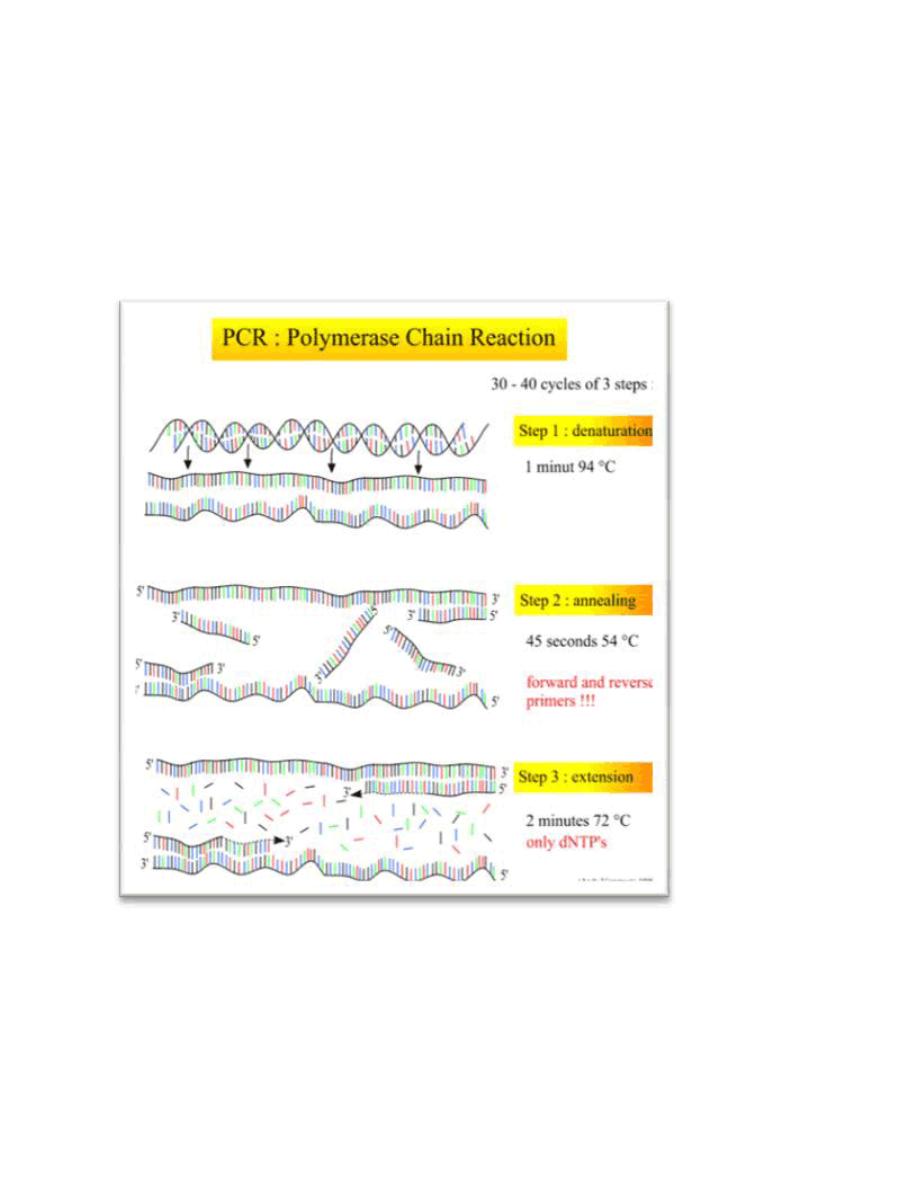
16
